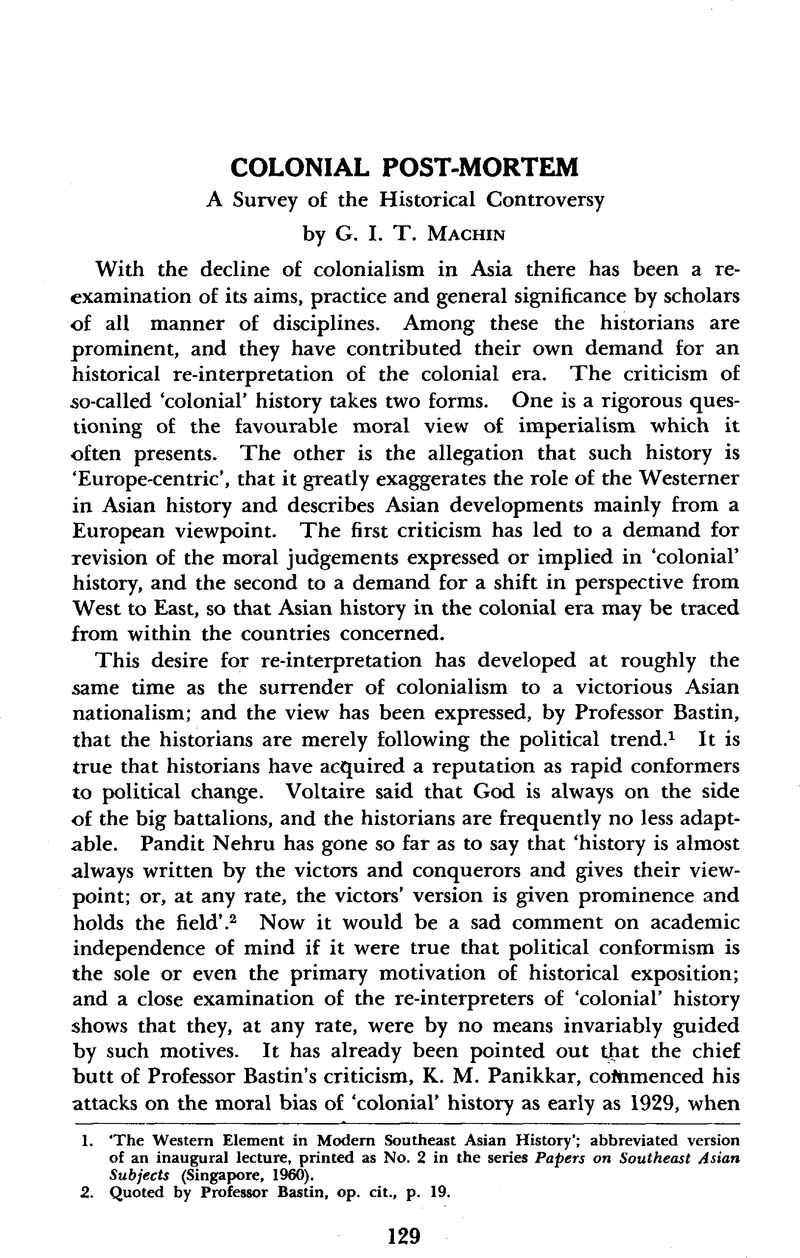Published online by Cambridge University Press: 24 August 2009

1. ‘The Western Element in Modern Southeast Asian History’; abbreviated version of an inaugural lecture, printed as No. 2 in the series Papers on Southeast Asian Subjects (Singapore, 1960).Google Scholar
2. Quoted by ProfessorBastin, , op. cit., p. 19.Google Scholar
3. Singhal, D. P., ‘Some Comments on “The Western Element in Modern Southeast Asian History”’, Journal of Southeast Asian History, vol. 1, no. 2 (09 1960), p. 121.Google Scholar The work to which DrSinghal, refers is Malabar and the Portuguese (Bombay, 1929).Google Scholar
4. Asia under Western Dominance (London, 1953).Google Scholar
5. This is in opposition to Dr. Singhal's view that because Panikkar expressed his opinions in 1929 he should be ‘absolved of complicity in the act of introducing political reaction in historical writings’ (‘Some Comments’, p. 121).Google Scholar A political reaction often commences long before it succeeds.
6. See Smail, John, ‘On the Possibility of an Autonomous History of Modern Southeast Asia’, Journal of Southeast Asian History, vol. 2, no. 2 (07, 1961), p 78.CrossRefGoogle Scholar
7. Asia in the European Age, 1498–1955. Thames, and Hudson, , London, 1962. Pp. 351.Google Scholar With maps and index. 35s.
8. In the following remarks I refer to the second edition of this work (London, 1959).
9. ‘The Western Element’, pp. 21–2.Google Scholar
10. ‘Some Comments’, p. 121.Google Scholar
11. ‘The Western Element’, p. 18.Google Scholar
12. Ibid., p. 21.
13. Ibid., p. 20.
14. By Smail, John, op. cit., p. 78.Google Scholar
15. Ibid.
16. ‘The Western Element’, p. 18.Google Scholar
17. ‘Some Comments’, p. 119.Google Scholar
18. Op. cit., p. 78.
19. ‘The Western Element’, pp. 16–17.Google Scholar
20. Ibid., pp. 15, 17.
21. ‘The Western Element’, p. 8.Google Scholar
22. It seems that Professor Bastin is not happy himself about the finality of his view. For though he says at one point that ‘no matter: how noble are the intentions of a Western historian to abandon a Europe-centric outlook, he will never quite escape from his own past, from his own cultural heritage’ (‘The Western Element’, p. 15)Google Scholar, he speaks immediately afterwards of ‘severe limitations’ to the possibility of western historians ever successfully interpreting Southeast Asian history from an Asian viewpoint (ibid.), and this is not quite so final. John Smail has already noticed this discrepancy (op. cit., p. 73).
23. ‘The Western Element’, p. 8.Google Scholar
24. See, e.g., three recent articles in the Journal of Southeast Asian History:John Smail, op. cit.; West, F. J., ‘The Study of Colonial History’ (vol. 2, no. 3, 10 1961, pp. 70–82)Google Scholar; and Benda, Harry, ‘The Structure of Southeast Asian History — Some Preliminary Observations’ (vol. 3, no. 1, 03 1962, pp. 106–38).Google Scholar
25. Indonesian Trade and Society (trans., The Hague, 1955), p. 261.Google Scholar